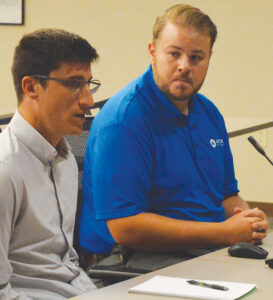Lyon Co. drug court grad rates near state target
Graduation for treatment program at 58% over past 3 years
MARSHALL — The graduation rate for Lyon County’s drug treatment court program is close to state goals, Lyon County Commissioners learned this week.
Over the past three fiscal years, a total of 17 people have graduated from the Lyon County treatment court, said program coordinator Alison Salazar. “Lyon County is at a 58% graduation rate, which is very close to the aspirational graduation rate that the state sets. So, we’re doing very good,” Salazar said. The state of Minnesota’s goal is for 60% graduation from treatment court programs.
Salazar gave an overview of the Lyon County drug treatment court program for county commissioners at their regular meeting Tuesday. She also made a funding request, for the county to continue reimbursing half the cost of drug testing done by the program.
“Drug court is a sentencing alternative for individuals who are suffering with substance abuse issues, and are also involved in the legal system,” Salazar said. Minnesota has different types of treatment courts, focused on offenders of different ages and with different needs. “Lyon County is a hybrid court, so we accept adult drug offenders and DWI offenders,” she said.
The treatment court program has five phases that participants go through. During the program, participants have regular court hearings, a curfew and drug testing, as well as other requirements including that they follow chemical dependency treatment recommendations and attend sober support meetings.
“We have a close working relationship between treatment and the criminal justice system, and we provide intense supervision for participants,” Salazar said. A treatment court team usually includes a judge, a probation representative, prosecution and defense lawyers and law enforcement.
Participants spend an average of 18 to 24 months in the program, she said. “Some people are in the program longer than that.”
Lyon County Attorney Abby Wikelius said one positive thing about the treatment court program was that it equipped participants with a new support network and skills, that can help them get treatment if they relapse, and avoid re-offending.
Salazar also shared statistics for the Lincoln and Lyon County treatment court. “Between fiscal year 2022 and 2025, we had 57 referrals (to treatment court), and 35 of those we accepted,” she said.
A total of 29 participants exited the treatment court program over the past three years, and 17 out of those 29 had graduated from the program.
Treatment court was one way to help address increasing problems with substance use in Minnesota, Salazar said.
“Drug overdoses in the past few years have been at record numbers,” Salazar said. “In 2021, there was 107,000 Americans that died of a drug overdose.” That same year, overdose became the leading cause of injury death in Minnesota, she said.
At the same time, less than 20% of incarcerated people with substance use disorders get treatment. Within three years of being released from prison, 95% relapse, Salazar said.
“Treatment court, on the other hand, does work. Treatment courts are six times more likely to keep people in treatment long enough for them to get better,” she said.
Salazar said the average cost of prison for one Minnesota inmate was around $40,000 in 2019. The annual cost of treatment court for one person was around $4,300.


